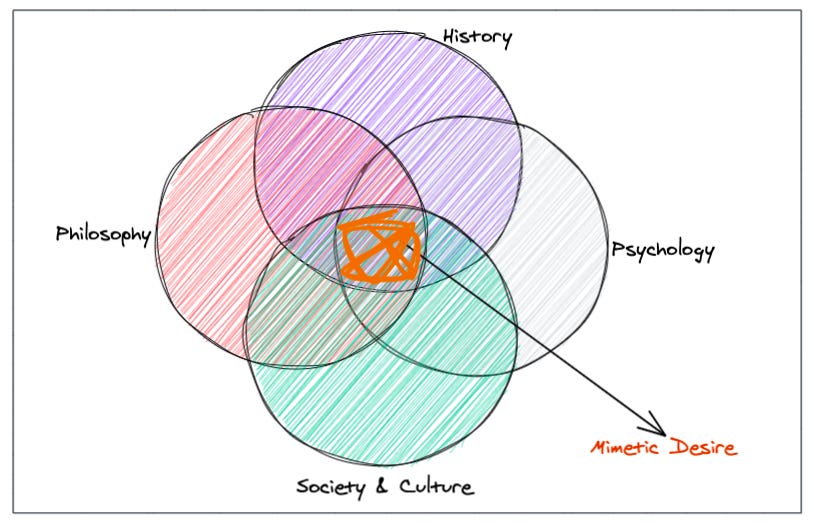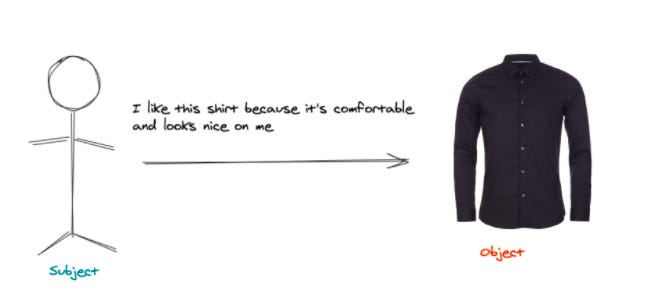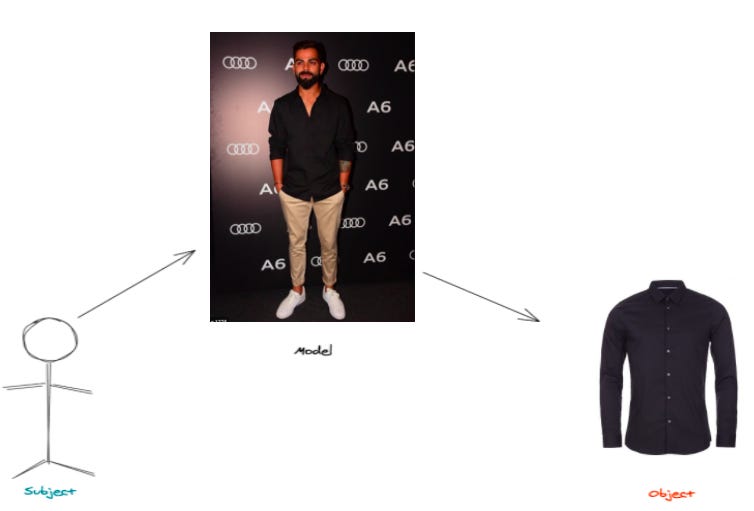Hello friends,
I have been chewing on the idea of mimetic desire for a while now, but it wasn’t until this week that I actually digested it.
We watch and learn by imitating others, and the most important thing we learn from others is desire. Rene Girard, a French Historian, Philosopher, and Stanford Professor spent his life around decoding human desires.
Why do we want specific things, objects, and people? This theory managed to answer some hard questions and constantly challenged my assumptions.
The Big Idea
Think of two kids and two identical toys.
One child picks up one toy, and immediately the other child has the unquenchable desire to take away that toy, ignoring the identical one right next to it.
This is a mimetic desire. We’re all guilty of doing this in one form or the other. Most of us anyway.
We want what others want. We want it because they want it.
Girard believed that human development occurs initially through a process of observational mimicry, where the infant develops desire through a process of learning to copy adult behaviour, fundamentally linking acquisition of identity, knowledge and material wealth to the development of a desire to have something others possess.
- Wikipedia
There was this widespread assumption that our desire is authentic and our own. Beyond food, shelter, sleep, and sex all our desires are adopted by observing the desires of other people.
To learn, a human needs a model; but as he copies his model, he also copies his model’s desires. Desire is triangular: it is a relationship not merely between a desirer and an object, but between an observer, a model, and the model’s object of desire.

A model can represent anybody - another person or a group of people who show us what is worth wanting.
As humans we imitate what we adore, it’s difficult not to imitate.
Baking banana bread
Dalgona coffee
Fashion
Advertising
These are some examples that depict how mimetic desires deeply govern our actions.
Mimetic Martini
Luke Burgis in his Anti-mimetic newsletter shared this brilliant example that hits the point home. Nobody does it better than the man himself, James Bond.
Rockstar meets Jim Morrison
There are some examples closer to home too. Remember Ranbir Kapoor in Rockstar?
In the song Nadaan Parindey, Ranbir has an altercation with the police and the public where he gives the crowd the finger.

While the scene feels truly iconic, Ranbir’s character actually mimics the legendary Jim Morrison flipping off the crowd and people going crazy. He talks about Jim in the movie, you can watch it from the 7 min mark here.
Glory Glory
Looking inwards, I realized a lot of my decisions could be attributed to my mimetic desires. 18 years ago, I started watching football. In my first ever live game an 18-year old Wayne Rooney scored a hattrick. I was blown away. I’ve been a Manchester United fan ever since.
But the story isn’t as straightforward as it seems. Me watching the game was down to the fact that my best friend was also a United fan. Being able to discuss games and talk strategy at the time meant being a part of an elite social group. A combination of status-seeking behavior powered by mimetic desires.
Advertising Industry & Mimetic Theory
Mimetic Theory is a great framework to understand how consumers make purchase decisions.
We think we make autonomous purchase decisions without outside influence. (“This shirt is wrinkle-free and doesn’t need to be ironed”) or personal preferences (“I like the way this shirt looks”).
In reality, Girard says, there is never a direct relationship between the consumer and the product. Instead, the relationship is always triangular between the subject, the object, and the model.
The model could be anyone - a celebrity, an Instagram influencer, someone you follow on Twitter, sometimes siblings and family members too.
Alex Danco’s brilliant piece that introduces Girard’s theories captures the essence of this idea perfectly.
Advertisers understand this principle really well: you’re not trying to convince somebody that they want Bud Light or a Ford F150; you’re telling them they ought to desire membership to a particular peer set, and the way to become a part of that group is to drink Bud Light and drive an F150. It’s why Abercrombie can advertise their clothes with models that aren’t actually wearing any of those clothes; the clothes aren’t the point.
What can you do to be anti-mimetic?
My first impression of the mimetic theory was all negative but on further probing, I realized mimetic desires aren’t that bad. In fact, they are intrinsically good.
Instead of letting models on social media shape your subconscious and eventually your reality, choosing the right models to imitate is mighty important. I’ve realized focusing on the skills and qualities of your models instead of the models themselves can help us become authentic and honest to our own self. Mimetic desire can be a powerful force for GOOD if intentionally channeled in the right way.
The first step to being anti-mimetic is to accept mimesis and not resist your desires. Some things that worked for me:
Using social media right - optimize your feeds. You don’t have to follow someone on social media just because you’re friends. I use Twitter to find interesting ideas, and talk to interesting people I can’t otherwise talk to, yet.
Surround yourself with amazing people - this is easier said than done, my key lesson from 2020 was to surround myself with people 10x smarter than me, learn how they think, and then apply those learnings to my own context. For example, If you surround yourself with other entrepreneurs you start to desire to start your own company and being successful.
Building habits - Over the last few years, I realized there is a common theme across the people I admire. They take simple ideas seriously. Ideas such as compounding, taking a step back observing & reflecting, second-order thinking, understanding systems. These felt like buzzwords to me which I was familiar with but didn’t truly internalize. Taking simple ideas seriously is hard.
I don’t have great answers on how to react after being exposed to mimetic theory so I leaned on heavyweights in the tech industry, folks who deeply understand the theory and have been able to create a disproportionate amount of wealth and value for the world.
Peter Thiel
It’d be almost criminal not to talk about Theil who popularized Girardian theories in the Tech world. His advice:
Look for secrets - work on projects that other people aren’t, think in ways other people aren’t thinking. The best problems to work on are the ones nobody else even tries to solve.
Escape the mainstream media and escape the conventional career track - take a leap of faith and escape the conventional realm too - don’t think too much about ridicule and criticism. Ignore society’s recommendations.
Be careful of who you copy - Theil encourages people to ask themselves “How do I become less competitive so that I can become more successful?”
To do all this Theil recommends starting with the question - “What important truth do very few people agree with you on?”
Kunal Shah
To quote Kunal “I suffer from insatiable curiosity. Every new insight or learning is useful someday in some form if you let it marinate.” Kunal shares a lot of great ideas but this tweet captures the essence of how to do your own thing.

Naval
To quote Naval “Material progress doesn’t make us happier. If it did, the ancients must have been a miserable bunch. Instead, we compete for status, an older, zero-sum game. A rational person recounts their blessings and rejects society’s games.”

One of my better moments from last year was understanding the fact that your default desires (which aren’t actually default) can be reprogrammed. The answer to some complex questions is to be disciplined about building habits and then paying close attention to the things one gravitates towards. Exploration is helpful, experimentation is important, but if we don’t have a feedback loop, we’re lost.
Blindly following your desires makes you a slave to your impulses — slave to the assumptions of those around you, the advertisements you’re exposed to, and the confused chemical signals of your body.
Going, Meta
Now would be a good time to put all my cards on the table. The idea of starting this newsletter wasn’t (can’t be) my own. Mimetic desires played their part here as well. Through this newsletter, I hope to question my assumptions, find my blind spots and truly follow my curiosity.
Starting this week I’m going to highlight one newsletter every week that inspires me.
For this week Wellness Wisdom by Patricia Mou. People looking to learn about wellness start-ups, personal development, and philosophy should absolutely subscribe. It’s magnificent.
Yours truly,
Vaibhav
PS: A massive thanks to Stew Fortier for a powerful thought-provoking conversation and for reviewing the first draft.
If you’re reading this newsletter for the first time, you can read previous issues and subscribe below.
I am Vaibhav K Achantani. I lead Content & Growth at an Edtech called Tekie. You can connect with me on Twitter or Linkedin.








A few months back I was redirected to "Secrets about People: A Short and Dangerous Introduction to René Girard" by Alex Danco by a tweet from Naval.
That was truly my introduction to Girard and his Mimetic theory. Took me full 10 days to go through the article and a lot of the things were way above my head. But I did understand the basic proposal of mimesis.
Since then, I have been consciously aware of mimetic theory, in practice, by me or around me.
And your article is in fact even more digestible, making it easier to comprehend and reflect on the examples as well. The examples are just on point. Right from Bond to Kunal Shah, this article was a bliss.